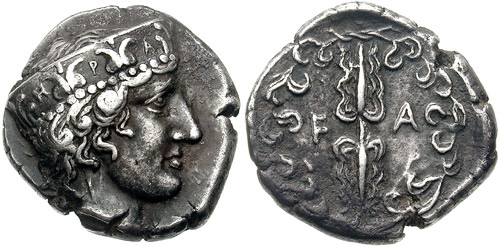Elis, silver, staters (various types related to Hera) (421-323 BCE)
From SILVER
(Redirected from AC 207 - Elis, silver, stater, 421-323 BC)
421 BCE - 323 BCE Silver 8,745 kg
Description
| ObverseInscription or printing placed on the obverse.: | Head of Hera right, wearing a bride's crown (polos) ornamented with palmettes and dots. |
| ReverseInscription or printing placed on the reverse.: | Letters F-A and flaming thunderbolt, all within olive wreath. |
Mint and issuing power
| MintIdentifies the place of manufacture or issue of a numismatic object.: | Elis | Ancient regionAncient region.: | Peloponnesus | Modern countryModern country: Greece | AuthorityIdentifies the issuing power. The authority can be "pretended" when the name or the portrait of X is on the coin but he/she was not the issuing power. It can also be "uncertain" when there is no mention of X on the coin but he/she was the issuing power according to the historical sources: |
Chronology
| FromIdentifies the initial date in a range assigned in a numismatic context. | 421 BCE | toIdentifies the final date in a range assigned in a numismatic context.. | 323 BCE | PeriodTime period of the numismatic object.: Classical 480-323 BC |
Physical description
| MetalThe physical material (usually metal) from which an object is made.: | Silver |
Median weightMedian of the weights of numismatic objects (in grams). in grams | 12.30 | DenominationTerm indicating the value of a numismatic object. Examples: tetradrachm, chalkous, denarius.: | stater |
StandardStandard.: |
Image

AC207 Olympia.jpg [1]
References
| Die study referencePublication of the study: | Seltman 19211Seltman 1921, series XXXVI-XXX, n° 242-364. | ||
| Coin series referenceReference to coin series study: | Sear I2Sear I, n° 2874, RQEMAC3RQEMAC, n° 207 | ||
Obverse dies distribution
| FrequencyFrequency of specimen in distribution. ᵖ | Number of obversesNumber of obverse dies. ᵖ (o) | % (o) | Number of coinsNumber of coins. (n) | % (n) | Die nameName(s) of the die(s). |
| 1 | 4 | 11.43 | 4 | 1.15 | EP, EV, FA, FD |
| 2 | 1 | 2.86 | 2 | 0.57 | FB |
| 3 | 1 | 2.86 | 3 | 0.86 | ET |
| 5 | 4 | 11.43 | 20 | 5.73 | EE, EO, EQ, EY |
| 6 | 4 | 11.43 | 24 | 6.88 | EB, ED, ES, FF |
| 7 | 3 | 8.57 | 21 | 6.02 | EG, EK, FH |
| 9 | 1 | 2.86 | 9 | 2.58 | FK |
| 10 | 2 | 5.71 | 20 | 5.73 | EH, FE |
| 11 | 3 | 8.57 | 33 | 9.46 | EM, EN, EW |
| 12 | 3 | 8.57 | 36 | 10.32 | EF, ER, EZ |
| 14 | 1 | 2.86 | 14 | 4.01 | EC |
| 15 | 1 | 2.86 | 15 | 4.3 | FC |
| 16 | 1 | 2.86 | 16 | 4.58 | LE |
| 17 | 1 | 2.86 | 17 | 4.87 | EU |
| 19 | 1 | 2.86 | 19 | 5.44 | EJ |
| 20 | 1 | 2.86 | 20 | 5.73 | FG |
| 21 | 1 | 2.86 | 21 | 6.02 | FJ |
| 25 | 1 | 2.86 | 25 | 7.16 | EA |
| 30 | 1 | 2.86 | 30 | 8.6 | EX |
| Total | 35 of 35 | 100.03 | 349 of 349 | 100.01 |
Reverse dies distribution
no distribution is available
Quantification
| Number of obversesNumber of obverse dies. ᵖ (o) | 35 | Number of singletons (o1)The number of singleton coins. ᵖ | 4 |
| Number of reverse diesNumber of reverse dies. (r) | 86 | Number of coinsNumber of coins. (n) | 349 |
| Coins per obverse dieNumber of coins per obverse die. (n/o) | 9.97 | Coins per reverse dieNumber of coins per reverse die. (n/r) | 4.06 |
| Reverse per obverse ratioRatio of obverse dies divided by reverse dies. (r/o) | 2.46 | Percentage of singletons (o1)number of coins (n) divided by the number of singletons (o1) ᵖ | 11.43 % |
| Original number of dies (O) (Carter 1983 formula)The estimation of the number of coins according to Carter 1983 ᵖ | 35.55 | Coins struck if 20,000 as average productivity per dieCoins made if the average productivity for obverses (according to Carter) is 20,000. ᵖ | 711,000 |
| Original number of dies (O) (Esty 2011 formula)The estimation of the number of coins according to the singleton formula in Esty 2011 ᵖ (O) | 38.9 | Survival rate if 20,000 as average productivity per dieSurvival rate if average productivity is 20,000. ᵖ | 0.00049 |
| Coverage (o = % of O) (Esty 1984 formula)Esty 1984 - coverage (% of O) ᵖ (o = % of O) | 98.85% | Die productivity if survival rate 1/2,000Average productivity if survival rate is 1/2,000. ᵖ | 19,634.32 |
| Weight of silver (in kg) if 20,000 coins per die (O = Carter formula)Carter 1983 * Median weight * 20000 (*10 if gold or electrum) ᵖ | 8,745 kg <br /> 8,745 kg | Die productivity if survival rate 1/5,000Average productivity if survival rate is 1/5,000. ᵖ | 49,085.79 |
Remarks